Arkansas Black Story
Arkansas Black is one of those apples that apparently holds no middle ground among apple fanciers; they either love it or hate it… Period. For those who despise the apple I prefer to think it’s just a case of misunderstanding. Arkansas Black is a fine apple with many exceptional merits that deserves more respect but, in order to properly enjoy the fruit one must exercise a bit of patience and give the apple a little extra time to become “all it can be”.
The apple is thought to have originated in the mid to late 1800’s in Bentonville, Arkansas, possibly discovered and raised by a settler named John Crawford. It certainly gained greater popularity later that century and could be found growing throughout Arkansas and Missouri and surrounding states. Believed to be a seedling of Winesap, the apple has many qualities similar to its better-known parent, namely a tart, tangy flavor and the ability to stay firm, crisp and flavorful after many months in storage. In fact, the apple reaches its peak in flavor and texture after a long period in cold storage. When first picked in October the apple can be as hard as a rock and almost as flavorful! Trying to enjoy the apple at this stage will usually lead to disappointment. However, after an extended period of storage, the apple undergoes a dramatic change and becomes a rather fine dessert apple. The sharp tartness mellows significantly into a rich sweetness that will surprise the skeptic who might have expressed some disdain with a freshly-picked apple. The hard, dense texture improves greatly as well, becoming a softer and more tender apple while still retaining a pleasing crispness.
The name is quite apt as the apple is very dark red in color with some specimens appearing almost black or purplish, especially when grown in full sun. Its deep red skin can be very tough, a quality that protects and preserves the apple so well when packed in storage bins for extended periods of time. The pale yellow flesh is sweet and rich with a complex flavor that has been described as “vanilla-like”, “almonds”, “red wine” and “honey-wine”.
Arkansas Black has always been favored as a quality dessert apple for fresh-eating but, like its parent, Winesap, it also has the well-earned reputation for producing outstanding cider. It is not an especially juicy apple but its sharp flavor makes a very good aromatic cider, particularly when blended with a sweeter cider apple. In addition, Arkansas Black is a wonderful cooking and processing apple. It holds its shape well when cooked so is popular for baking whole and pie making. If you’re looking for world-class apple pie, combine a tangy Arkansas Black with a sweet Porter apple. Outstanding!
Arkansas Black is a triploid apple with an extra set of chromosomes. Like all triploid apples it produces sterile pollen and is thus incapable of pollinating other apple varieties. When planting Arkansas Black trees it is very important to have another pollen-fertile variety nearby so they can be properly pollinated. Then, to ensure the second pollen-fertile apple tree will be successfully pollinated, it is critical to have a third pollen-fertile variety to pollinate the second tree since the Arkansas Black cannot pollinate the second tree! Confused yet?! Great pollinating apples such as Golden Delicious, Grimes Golden, Winter Banana, Snow or Yates would all be great complementary varieties to grow alongside Arkansas Black.
For those cynics who would normally “thumb their nose” at a basket of freshly-picked Arkansas Black apples I suggest they give this old variety another chance. After you pick the Arkansas Black in October put them in the root cellar for a couple of months while you enjoy your other fall apples. Then in April when the other apples have been consumed, pull out the Arkansas Black’s and give them another taste. Go ahead and try them; you just might be surprised how good they really are!



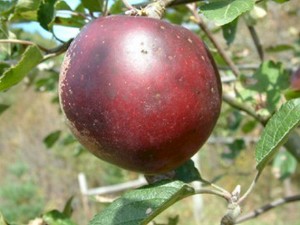
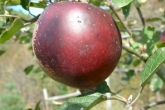
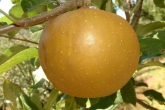
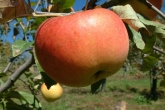
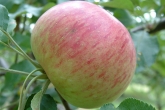








Hey, Ron, I really enjoyed your post about Arkansas Black. I’ve been growing it here in Arkansas for 35 years now, and I’ll add another reason for the discrepancies in perceived quality among consumers of this heirloom variety. Perhaps more than any other apple I grow or have grown, the flavor (at least as it comes off the tree) varies year-to-year with the Black. This year is one of the good years, with apples coming right off the tree fully flavored with that “adult” blend of sugars, acids, and tannins. I believe it is the tannins that give it it’s vinous (wine-like) flavor. It really blew people away this year at the Fayetteville Farmers Market, where I sell much of my fruit. Most years, however, I have to give customers a printed handout or my regular spiel about curing it and being patient, much like you said in your blog. But some years–wow! And this was one of those!!!! Heck, I’m going to pull my Arkansas Black out of my lunch sack and eat it now!
Hi Guy,
Thanks for sharing your insightful observations about Arkansas Black. We have several old heritage varieties that, like Arkansas Black, can also vary significantly in flavor and quality year-to-year, probably due to seasonal weather conditions. Some Limbertwig varieties can be like this. As you noted, this was an exceptionally good year for quality, if not in quantity. Although we had a significantly reduced crop this season, the apples we produced were outstanding, including the Limbertwigs.
The few Arkansas Blacks we harvested this year were surprisingly flavorful fresh off the tree. They were still rock-hard but quite tasty! Like you, I still advised buyers to “stick them in the refrigerator” for a few weeks so they’ll improve in flavor and texture. I like your idea of providing a printed handout describing what consumers can do to improve the quality of some of these late-season apples. The flavor improvement after an extended period of cold storage can be very dramatic for a lot of different apples.
Thanks again for writing. I hope you and yours enjoy a safe and warm Holiday Season.
Regards,
Ron
This is my favorite apple! I always get them from my local farmer’s market and have never had a problem with flavor. There is nothing better as far as taste and texture goes in my opinion. I’m going to try cooking with them soon. Thanks for taking the time to post this info!
I’m pleased you enjoyed this post, Abby. I hope the story of Arkansas Black has persuaded some “fence-sitters” to appreciate the fine qualities of this old heritage apple. Thanks for sharing your thoughts.
When considering another apple apple variety for pollination of the Arkansas Black would a Winesap work? Or would the pollen be too similar and pollination would fail? Any thoughts would be appreciated. Cheers.
I hunted back in mt.of NC there is a old Apple orchard no one takes care of it any more in late Nov. I have scratched out of the tall grass coverd in snow apples that looked like the Arkansas Black you show the old men I hunted with said they were Black Ben’s. But they were a great eating apple. After getting ripe.
My wife and I love the Arkansas Black Apples, We buy a bushel every time we are in that country. They keep good and stay crisp. I cant’ stand buying an apple and it’s soft.
I realize this thread is pretty old, but I”m going to just try….I am a chef from California, and I need a case of Arkansas Blacks for a special event. Does anyone know where I might look for a case of these?
Did you ever find a place to buy the Arkansas black Apples? I would love to be able to buy a few cases. they make the best cider and apple sauce. If you find them can you please text me at 731 926 5442 I live in the country and have very limited access to the internet.
I know this is a pretty old post too but I found this blog after I just picked some Arkansas Black in Oak Glen, California yesterday! Los Rios Ranchos has them. Go check it out before they are gone for the year!
My Mama made jelly from some Arkansas Blacks and not only was it a beautiful rich color it was full of flavor. Apple jelly has always been my favorite. I may have a jar or 2 left. Daddy planted some trees, but they never really took off and eventually died.
Hi Lynn,
I’ve never seen nor enjoyed apple jelly made from Ark Blacks before but your comment about its beautiful rich color really captured my imagination. Being such a dark apple I’m thinking it makes a beautiful dark amber jelly. Would I be right? Thanks for sharing your memories.
Ron
What zone does this tree grow in. Is it worth trying in 3b
I live near Grand Rapids Michigan and my Ark Black thrives. I just picked it nearly clean tonight (Nov 6th, 2017). But still quite hard. They were more tart last year. Not so tart this year. But I do think my season-length is borderline for this tree. Last year was good. This year, had to run them right up the night of the first hard-frost to get to the point where they would pick without ripping off too many spurs. The old lift and twist was just not quite enough with some of them. Had to work hard to get the abcision-layer to separate.